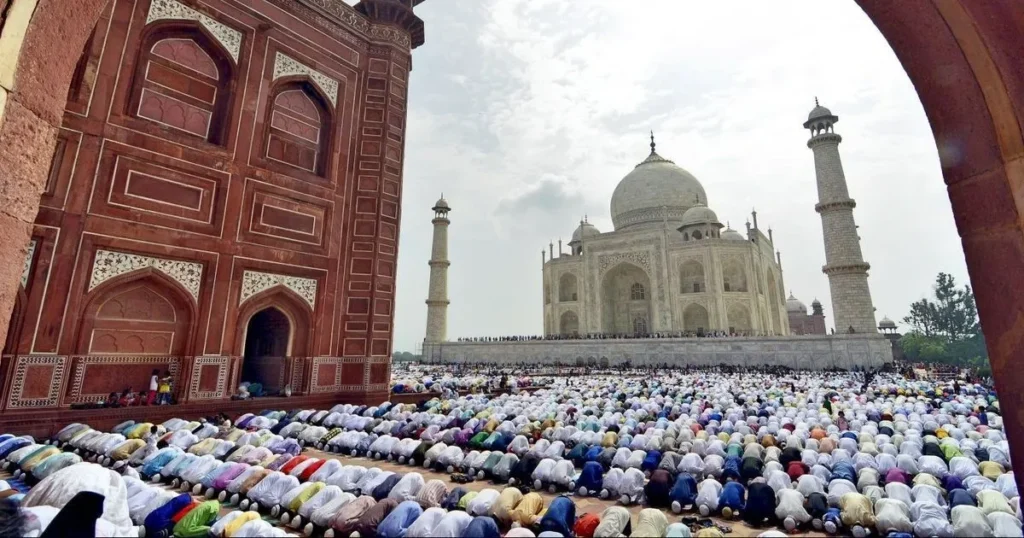Waqf Act 1995 – Law, Working, Activities and Ban Debate

For the start, we need to understand what Waqf is, its history, how it operates, who the people involved and what are the major points of controversy around Waqf in India. In this article, we will provide all this information about the Waqf Act 1995 along with the important aspects that are key factors that lead to the points of dispute.
Even before and after partition in 1947, India has always been in multi-cultural disputes and the Waqf Board is just one of them. But wait is it just a ‘Board’ or more than that? Is it a religious practice or a loophole to acquire land illegally, as claimed on social media these days?
What is its History and why is it only coming to light now? What is the political role and impact? Answers to these questions are elliptical but let’s be concise and understand it better.
Definition of Waqf & Its Law
Waqf refers to property that is movable or immovable given/donated in the name of God (Allah) for religious and charitable purposes. The person who does or makes Waqf is called Waqif and has to be an adult MUSLIM of sound mind.
Under the “Muslim Waqf Act 1913, Section 2 (1) Waqf” means the permanent dedication by a person professing the “Mussalman” faith of any property for any purpose recognized by the Mussalman law as religious, pious, or charitable.

According to the the law stated above one can easily comprehend that neither a non-Muslim nor their property of any kind can be donated or be used for charitable purposes, thus out of the purview of Waqf. In addition to that property obtained by Waqf cannot be sold nor be used for commercial purposes. Now the basics are clear let’s move to other important information
Establishment of Waqf Board And Its Work
The Waqf Act of 1954 authorized by Jawaharlal Nehru’s government made a way for the Centralization of Waqfs. Central Waqf Council of India, a statutory body was established in 1964 by the government of India under the Waqf Act of 1954. The primary objective of this council is to supervise the work under various state Waqf boards which were established under provisions of Section 9(1) of the Waqf Act 1954.
Over 35,000 Waqf institutions and 32 Waqf boards in India have 2 castes, Sunni and Shia. However, some cities and towns don’t have Waqf institutions such as Goa, Arunachal Pradesh, Mizoram, Nagaland, Sikkim, and the UT Daman & DIU. Broadly there are 5 Lakh plus registered and non-registered waqf board property with a land area of 9.5 lakh acres worth over Rs 2 Lakh crore. This land can generate Rs 20,000 crore in revenue annually and is currently under Waqf’s possession.
But debatably the question that arises is How is it possible for a Minority Association for Charitable purpose to have 9.5 lakh acres of land and become India’s 3rd largest land owner after the Ministry of Defence and the Ministry of Railway?
Waqf Act 1995
Waqf Act 1995[1] Section 52A was a formidable allowance given to the Waqf Board that allowed them to do as they please without anybody raising a question. Under this law, no individual or entity can file a lawsuit against the Waqf Central Board if their land has been declared Waqf. The only hearing will be held in the ‘ Waqf Tribunal a special Court’ – the sole authority that can adjudicate disputes such as eviction and determination of the rights of lessor and lessee pertaining to Waqf properties.
Where 20 members are present and 1 educated chairperson from the community will decide whether the land is Waqf’s or the individual’s, based on the proof the individual provides for the ownership of the Land. As per Waqf Act 1995 Section 52A (3), even the constitutional courts shall not take cognizance of any offense except on a complaint made by the Board.
There have been many instances where Waqf Board properties are disputed and the Waqf Act 1995 is called ‘India’s Biggest Land Scam. Let’s look at a few examples.
2005 Taj Mahal Case
The Sunni Waqf Board told the Supreme Court that the Taj Mahal is Waqfs’ Board property because every Friday, there are prayers held and Muslim activities are carried out. But does this reason suffice for the Taj Mahal to be declared Waqf?

From the above definition of Waqf and its Laws, we understand that it is a property given/donated by a Muslim individual for charitable purposes it comes under Waqf Board properties. Therefore just because Muslim prayers are held every Friday in the Taj Mahal does not make it Waqf and has to be proved that the Taj Mahal was donated to Waqf or Is Taj Mahal property of the Waqf board?
Arguably Shah Jahan built the Taj Mahal in his wife’s love (though this is also debatable) and nowhere did he declare it Waqf, neither before nor after passing away. And this was the same point made in the Supreme Court, where the judge said ‘Bring proof that Shah Jahan declared the Taj Mahal Waqf’. The Sunni Waqf Council failed to do so and thus the Taj Mahal remained the Archaeological Survey of India’s property.
Tamil Nadu’s Entire Village and 1500 Year Old Mandir
In Tiruchirapalli, there is a village called Thiruchenthurai which has a 1500-year-old Mandir and a sizeable inhabited Hindu population. Once Raj Gopal was trying to sell his 1.2-acre plot to afford his daughter’s wedding. When he was informed by Local authorities that he needed a ‘No Objection Certificate’ from the Tamil Nadu Waqf Board. He was handed a 20-page long document that stated the ownership of the entire village is with Waqfs’ Board.

Villagers were in shock and all of them went to check their land’s property documents and found no such details. However, the Waqf board presented documents that indicated resettlement from 1927 – 1928 of all lands in the village. But is that it? Is the 1500-year-old Hindu temple Waqf Board property even if it is against Islamic Law? These are the instances that poured light onto the matter.
Modi Government and Waqf
Modi Government took back 123 properties ‘gifted’ by the Congress government before the 2014 elections to Waqf in Delhi. These properties included mosques, dargahs, and a cemetery. Eventually, APP MLA Amantullah Khan filed a case in the Delhi High Court. In March 2022 the Delhi High Court refused to provide relief to the Delhi Waqf Board regarding the 123 properties.
Up until now, the Waqf Board had been working in the shadows and been given the benefit of the doubt. But in Oct 2023 ED and Anti-Corruption Branch raided AAP MLA and Delhi Waqf Board Chairman Amanatullah Khan’s house and found evidence that shook the masses about the Waqf board activities in the name of charity.
ED Raid Delhi Waqf Board Chairman Amanatullah Khan
Oct 2023 ED (enforcement Directorate) raids on the then Delhi Waqf Board Chairman brought out astonishing facts as to what was being done with so many properties. Waqf board of Delhi has used these properties for commercial purposes. Tenants had been living in the properties and illegal properties were sold on an unofficial basis away from Law’s eyes. All transactions were done in cash and several properties had already been dealt with. Despite the fact Waqf is a charitable organization, therefore the term ‘scam’.
Below are cases where Waqf misused its given authorities and violated basic human rights to land possession.
- Tamil Nadu’s 7 villages were claimed Waqf including 1500 year old Mandir without any sensible explanation. Residents were told to change their faith to Islam if they wanted their land back or else vacate their homes.
- In July 2022, A court granted Gurudwara land to Waqf board in Haryana’s Yamunanagar District. Which resulted in residents protesting against the court’s rulings.
- Surat Municipal Corporation Headquarters at Muglisara had been declared Waqf Board property. With a baseless explanation from the Waqf board saying Shah Jahan’s begum owned the Entire Surat.
- A failed attempt was made by the Waqf board to acquire two islands in Beyt Dwarka. And got a befitting reply from the Gujarat High Court ‘Are you aware of what you are saying? How can Waqf Board claim ownership of land in Krishnanagari?’. Beyt Dwarka was the residence of Shri Krishna during the time he ruled Gujarat and the application was denied.
These are just a few examples of the times when the Waqf board acquired land illegally. But what has anybody done to stop it and rectify the mistakes made? Muslim Countries and Waqf
People who claim injustice to Muslims in India should know that there is No Waqf in the Islamic Countries of Turkey, Libya, Egypt, Sudan, Lebanon, Syria, Jordan, Tunisia, and Iraq.
However, Muslims always have been vote banks, and various political parties have tried different ways to appease the community. Waqf Board has become the largest urban landowner in India and legally protects itself without the intervention of the court.
Mahabharata Era Lakshagriha Restored to Hindus
The latest case wherein a 52-year-old legal battle is settled and the waqf land was restored to Hindus against the claim of Waqf. The place is declared as the LakshaGriha from the Mahabharat era that Pandavas used to escape the fire. The land was claimed by Waqf as a shrine and graveyard and was shown as registered under the Sunni Waqf Board.
With several instances of land grabbing and injustices reports coming out, a Pan India debate is going on to ban the Waqf. The voices in Lok Sabha, Rajya Sabha, and the internet are echoing loudly. As per reports After the Lok Sabha Elections of 2024 and as BJP and Prime Minister Modi is confident to come back to power, some action is expected.
Modi strongly put his foot forward for the Modi 3.0 government and is expected to work on issues like CAA, Rohingyas, the Waqf Act, Uniform Civil Code that has been long due.
Krishna JanmBhoomi Mathura and GyanVapi Kashi Vishwanath issues are in court at the moment and Hindus are expecting a win in these cases soon.
